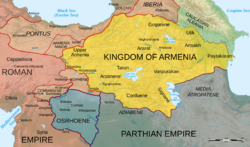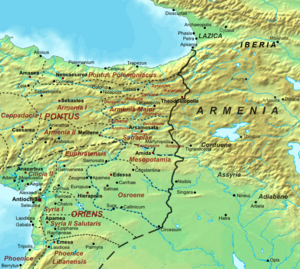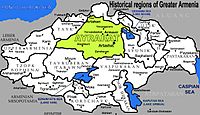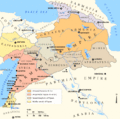Kingdom of Armenia (antiquity) facts for kids
Quick facts for kids
Armenia
Հայք |
|||||||||||
|---|---|---|---|---|---|---|---|---|---|---|---|
| 331 BC–428 AD | |||||||||||
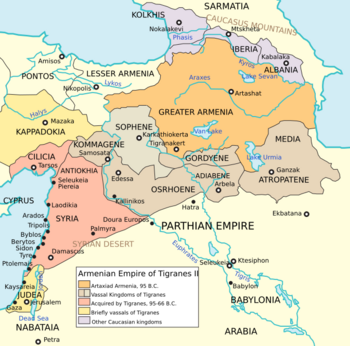
Armenia at its greatest extent under Tigranes the Great, 69 BC (including vassals)
|
|||||||||||
| Status | Satrapy, Kingdom, Empire, Province | ||||||||||
| Capital | Armavir (331–210 BC) Yervandashat (210–176 BC) Artashat (176–77 BC; 69–120 AD) Tigranocerta (77 BC–69 AD) Vagharshapat (120–330) Dvin (336–428) |
||||||||||
| Common languages | Armenian (spoken native language) Greek Aramaic Iranian languages (Parthian and Middle Persian) |
||||||||||
| Religion |
|
||||||||||
| Government | Monarchy | ||||||||||
| King, King of Kings | |||||||||||
|
• 331–317 BC
|
Orontes III | ||||||||||
|
• 422–428
|
Artaxias IV | ||||||||||
| Historical era | Antiquity, Middle Ages | ||||||||||
|
• Satrapy of Armenia is formed
|
c. 533 BC | ||||||||||
|
• Reign of Orontes III begins
|
331 BC | ||||||||||
|
• Treaty of Rhandeia
|
63 AD | ||||||||||
|
• Christianity declared state religion
|
301 AD | ||||||||||
|
• Partition of Armenia
|
387 AD | ||||||||||
|
• Last Arsacid king of Armenia deposed
|
428 AD | ||||||||||
| Area | |||||||||||
| c. 70 BC | 900,000 km2 (350,000 sq mi) | ||||||||||
| c. 300 AD | 311,000 km2 (120,000 sq mi) | ||||||||||
| Population | |||||||||||
|
• c. 70 BC
|
10,000,000 | ||||||||||
|
• c. 300 AD
|
4,000,000 | ||||||||||
| Currency | Taghand | ||||||||||
|
|||||||||||
Armenia, also known as the Kingdom of Greater Armenia, was an important kingdom in the Ancient Near East. It existed for a long time, from 331 BC to 428 AD. During its history, three main royal families ruled: the Orontid dynasty (331 BC–200 BC), the Artaxiad dynasty (189 BC–12 AD), and the Arsacid dynasty (52–428 AD).
The kingdom started as a part of the Persian Achaemenid Empire. This area was called the Satrapy of Armenia. It was formed from the land of the Kingdom of Ararat after it was conquered in 590 BC. Armenia became its own kingdom in 321 BC under the Orontid family. This happened after Alexander the Great conquered Persia. Later, Armenia became one of the Greek-influenced kingdoms within the Seleucid Empire.
Under the Seleucid Empire, the Armenian throne was split into two parts: Greater Armenia and Sophene. In 189 BC, both parts came under the rule of the Artaxiad dynasty. The Kingdom of Armenia grew very powerful under Tigranes the Great. From 83 to 69 BC, it became a large empire. It took over Sophene and other lands from the falling Seleucid Empire. However, the powerful Roman Republic soon conquered Armenia in 69 BC. The Artaxiad kings then ruled as "client kings" for Rome. This means they were allowed to rule their land but had to follow Rome's orders. They were removed in 12 AD, possibly because they supported Rome's rival, Parthia.
During the wars between the Romans and the Parthians, the Arsacid dynasty of Armenia began. Tiridates I, who was related to the Parthian Arsacid family, became King of Armenia in 52 AD. For much of this time, Armenia was a battleground between Rome and Parthia. The Armenian noble families were often divided, supporting either Rome, Parthia, or trying to stay neutral. From 114 to 118 AD, Armenia was briefly a Roman province under Emperor Trajan. The Kingdom of Armenia often acted as a "buffer state." This means it was a small country between two larger, powerful empires, like Rome and Parthia (and later the Byzantine and Sassanid empires). In 301 AD, Tiridates III made Christianity the official state religion of Armenia. This made Armenia the first country in history to officially adopt Christianity.
In 387 AD, Armenia was divided into Byzantine Armenia (controlled by the Eastern Roman Empire) and Persian Armenia (controlled by the Sassanid Empire). The last Arsacid king of Armenia was removed in 428 AD. This ended Armenia's independence until the Bagratid kingdom appeared in the 9th century.
Contents
History of Ancient Armenia
Early Beginnings
Before the 9th century BC, the area known as the Armenian Highlands was home to many different tribes. These tribes did not yet form a single state or nation. The first major kingdom to rule a large part of this area was the Kingdom of Urartu. It was also called the Kingdom of Van or Ararat. This kingdom often fought with Assyria for control of the highlands.
Both Urartu and Assyria were later conquered by invaders from the east. These were the Medes and then the Persian Achaemenid Empire in the 6th century BC. The land was then organized into a region called Armenia. The Orontid dynasty ruled Armenia as governors for the Achaemenid Empire for 300 years. This changed after Alexander the Great defeated the Achaemenid Empire in 331 BC. After Alexander's death in 323 BC, the Orontids returned. This time, they ruled as kings, not just governors.
The Orontid Dynasty
Orontes III and Mithridates, the ruler of Lesser Armenia, declared themselves independent. This made Armenia and Lesser Armenia into separate kingdoms. Orontes III also defeated a commander named Menon, who wanted to take control of the gold mines in Sper.
The Seleucid Empire (which followed Alexander's empire) grew stronger and weakened Armenia. The last Orontid king, Orontes IV, was overthrown around 201/200 BC. A Seleucid commander named Artaxias I then took over the kingdom. It is thought that Artaxias was also related to the Orontid family.
The Artaxiad Dynasty
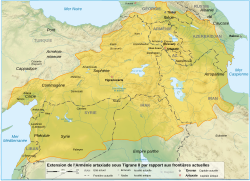
The Seleucid Empire lost much of its power over Armenia after being defeated by the Romans in 190 BC. In the same year, Artaxias I founded a new Armenian state. He also ruled alongside the Armenian kingdom of Sophene, led by Zariadres. Artaxias captured Yervandashat. He united the Armenian Highlands and built a new royal capital called Artaxata. This city was near the Araxes River.
Some ancient writers, like Strabo and Plutarch, say that the famous general Hannibal was welcomed by Artaxias I. They even tell a story that Hannibal helped plan and build Artaxata. The new city was in a great location for trade. It connected the Ancient Greek world with places like Bactria, India, and the Black Sea. This helped Armenia become rich.
Tigranes the Great saw a chance to expand Armenia. In 83 BC, he was invited to Syria during a civil war there. He soon became the ruler of Syria, which effectively ended the Seleucid Empire. For 17 years, Tigranes ruled peacefully. At the height of his power, Tigranes the Great expanded Armenia's land far beyond the Armenian Highlands. His empire included parts of the Caucasus, modern-day Turkey, Iran, Syria, and Lebanon. Armenia became one of the most powerful states in the Roman East for a short time. However, Rome conquered it in 69 BC.
Armenia Under Roman Influence
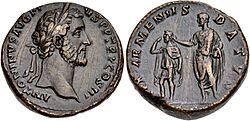
Armenia became a "client kingdom" of the Roman Empire in 66 BC. This happened after Rome defeated Armenia's ally, Mithridates VI of Pontus.
Mark Antony invaded Armenia and defeated the kingdom in 34 BC. But the Romans lost control during their own civil war from 32–30 BC. In 20 BC, Augustus made a peace deal with the Parthian Empire. This made Armenia a "buffer zone" between the two powerful empires.
Augustus put Tigranes V on the throne in 6 AD. Later, the Romans installed Mithridates of Armenia as a client king. Armenia often became a point of conflict between Rome and Parthia. Both empires supported different kings or rulers in Armenia. From 37 AD, the Parthians forced Armenia to obey them. But in 47 AD, the Romans took back control. The period of fighting ended in 66 AD. This is when Tiridates I of Armenia was crowned king of Armenia by Nero. Even though Rome still considered Armenia a client kingdom, the ruling family was Parthian. Roman writers at the time thought that Nero had actually given Armenia to the Parthians.
The Arsacid Dynasty
Under Nero, the Romans fought a war (55–63 AD) against the Parthian Empire. The Parthians had invaded the Kingdom of Armenia, which was allied with the Romans. After some battles, an agreement was reached in 63 AD, called the Treaty of Rhandeia. This treaty stated that members of the Parthian Arsacid family would rule Armenia. They would be client kings, meaning they ruled Armenia but were still under Rome's influence.
Another war happened from 162–165 AD. This was after Vologases IV of Parthia invaded Armenia. Emperor Lucius Verus led a Roman army to the east. His army won important battles and took back the capital city. Sohaemus, a Roman citizen with Armenian roots, was made the new client king. But a disease spread through the Roman army. The Parthians then took back most of their lost land in 166 AD. Sohaemus went back to Syria, and the Arsacid dynasty was put back in power in Armenia.
After the Arsacid family lost power in Persia, the new Sassanid Empire wanted to control Armenia again. The Sassanid Persians occupied Armenia in 252 AD. However, in 287 AD, Tiridates III the Great became king with the help of the Roman armies. After Gregory the Illuminator spread Christianity in Armenia, Tiridates accepted Christianity. He made it the official religion of his kingdom. Armenia officially became Christian in 301 AD. This was about a dozen years before the Roman Emperor Constantine the Great became Christian.
In 387 AD, the Kingdom of Armenia was split between the Eastern Roman Empire and the Sassanid Empire. Western Armenia became a Roman province called Armenia Minor, and later Byzantine Armenia. Eastern Armenia remained a kingdom within Persia. But in 428 AD, the local nobles removed the king. The Sassanids then put a marzban (governor) in charge. This started the Marzpanate period over Persian Armenia. These parts of historical Armenia stayed under Persian control until the Muslim conquest of Persia. The Byzantine parts were also conquered by Arab armies in the 7th century. In 885 AD, after years of Roman, Persian, and Arab rule, Armenia became independent again under the Bagratuni dynasty.
Armenian Military Power
The Army of Tigranes the Great
The army of the Kingdom of Armenia was strongest under Tigranes the Great. Some ancient writings say his army had chariots and 12,000 cavalrymen. These were likely heavy cavalry or cataphracts, which were heavily armored horsemen. His army also had 120,000 foot soldiers and 12,000 mounted archers.
The Jewish historian Josephus wrote that Tigranes' army had 500,000 people in total. This included many camp followers. These followers brought camels, donkeys, mules for baggage, and animals like sheep and cattle for food. They also carried lots of gold and silver. Because of this, the Armenian army was described as "a huge, irregular force, too many to count." While impressive in size, smaller, well-organized armies like the Roman legions often posed a greater challenge.
It's important to remember that the numbers given by ancient historians might have been exaggerated. This is especially true since the Jewish people lost their war against Tigranes.
Plutarch wrote that Armenian archers could kill from 200 meters with their very accurate arrows. The Romans admired the bravery and fighting spirit of the Armenian Cavalry. This cavalry was the main part of Tigran's Army. The Roman historian Sallustius Crispus wrote that the Armenian [Ayrudzi – meaning horsemen] Cavalry was "remarkable by the beauty of their horses and armor." Horses in Armenia, since ancient times, were seen as the most important part and pride of a warrior.
Ayrudzi: Armenian Horsemen
Since ancient times, the Kingdom of Armenia had a special cavalry unit called "Azatavrear." This group was made up mostly of elite Armenians. The "Azatavrear" cavalry formed the main part of the king's guards. Later, in medieval times, this cavalry was called Ayrudzi, or "horsemen." They were often the youngest sons of Armenian lords.
During times of peace, Armenian cavalry were split into small groups. Their job was to guard the King, other Armenian lords, and their families. Some cavalry units always patrolled the Armenian borders. They were led by an Armenian general called a sparapet. The group of cavalry protecting the Armenian king and his family had 6,000 heavily armored horsemen in ancient times. In the medieval period, this number was 3,000. During wars, the number of Armenian cavalry would increase. Estimates range from 10,000 to at least 20,000 horsemen. Besides heavy cavalry, there was also light cavalry, mainly made up of mounted archers.
Legio I Armeniaca: The First Armenian Legion
"Legio Armeniaca" means "Armenian Legion" in Latin, and "prima" means "first." The Armenian First Legion was a Roman imperial legion from a later period. This Legion is mentioned in an old text called Notitia Dignitatum. It was probably formed in the 2nd or 3rd century AD. Its mission was to protect Armenian lands that were under Roman control.
The Armenian First Legion took part in Emperor Julianus Apostata's Persian campaign in 363 AD. This campaign did not go well.
Legio II Armeniaca: The Second Armenian Legion
"Legio Armeniaca" means "Armenian Legion" in Latin, and "Secunda" means "Second." Like the First Legion, the Armenian Second Legion was a Roman imperial legion from a later period. This legion is also mentioned in the Notitia Dignitatum. The Armenian Second Legion is thought to have been created around the end of the 3rd century or the beginning of the 4th century.
The Armenian Second Legion had a permanent camp in one of the northern provinces of the Roman East. It built a camp in Satala. In 360 AD, the Armenian Second Legion was part of the army protecting Bezabda (an ancient city). In Bezabde, the Armenian Second Legion served alongside other Roman Legions. In 390 AD, the Persian army took Bezabde. A terrible battle happened against the people and the soldiers there. However, the legion seems to have survived this battle. It appears in the Notitia Dignitatum, which was written in the 5th century. Later, the Armenian Second Legion became part of the Byzantine army.
Ancient Armenian Beliefs
Before Christianity, Armenians had their own gods and goddesses. Here are some of them:
- Aramazd – This god was similar to the Iranian god Ahura Mazda. He was the main god, like Zeus in Greek mythology.
- Amanor and/or Vanatur – The god of the Armenian New Year, Navasard, which was at the end of July.
- Anahit – Similar to the Iranian goddess Anahita. She was the goddess of fertility and birth. She was thought to be Aramazd's daughter or wife. She was like Artemis and Aphrodite.
- Ara the Beautiful – A god who was said to die and come back to life. He was killed in a war against Semiramis.
- Astghik – Similar to the Semitic goddess Ishtar. She was a fertility goddess and the partner of Vahagn. The holiday of Vardavar was originally in her honor.
- Barsamin – The god of the sky and weather. He was probably based on the Semitic god Baal Shamin.
- Hayk – The legendary ancestor of the Armenian people. He was a great archer and killed the giant Bel.
- Mihr – Similar to the Persian god Mithra. He was the god of the sun and light, and the son of Aramazd.
- Nane – Possibly similar to the Sumerian goddess Nanaya. She was Aramazd's daughter and a goddess of war and motherhood.
- Tir or Tiur – The god of wisdom, culture, and learning. He also interpreted dreams. He was the messenger of the gods, like Apollo.
- Tsovinar – Also called Nar, she was the goddess of rain, sea, and water. She was thought to be a fiery being who made rain fall.
- Vahagn – Similar to the Iranian god Verethragna. He was the storm god and a hero who killed dragons.
During the 1st century AD, Christianity began to spread in Armenia. Legends say this was due to the efforts of the apostles Bartholomew and Thaddeus. After some kings tried to stop it, Christianity was adopted as the state religion by King Tiridates III. He was converted by Gregory the Illuminator. Armenia became the first country to officially adopt Christianity as its state religion in 301 AD. This was before the Roman Emperor Constantine the Great became Christian.
Zoroastrianism in Armenia
Until the late Parthian period, Armenia was mostly a land where people followed Zoroastrianism. When Christianity arrived, both paganism and Zoroastrianism slowly started to fade away. The founder of the Arsacid family in Armenia, Tiridates I, was a Zoroastrian priest. A famous story shows how the Armenian Arsacids followed Zoroastrianism: Tiridates I made a special journey to Rome in 65–66 AD. After Christianity was adopted in the early 4th century, Zoroastrianism's influence in the kingdom slowly declined.
Armenian Literature
We don't know much about Armenian literature from before Christianity. Many old writings were saved and shared by Moses of Chorene. Here is an ancient Armenian song about the birth of the god Vahagn:
Armenian version
Երկնէր երկին, երկնէր երկիր,
Երկնէր եւ ծովն ծիրանի,
Երկն ի ծովուն ունէր և զկարմրիկն եղեգնիկ։
Ընդ եղեգան փող ծուխ ելանէր,
Ընդ եղեգան փող բոց ելանէր,
Եւ ի բոցոյն վազէր խարտեաշ պատանեկիկ։
Նա հուր հեր ունէր,
Բոց ունէր մօրուս,
Եւ աչքունքն էին արեգակունք։
Translation
In travail were heaven and earth,
In travail, too, the purple sea,
The travail held in the sea the small red reed.
Through the hollow of the stalk came forth smoke,
Through the hollow of the stalk came forth flame,
And out of the flame a youth ran․
Fiery hair had he,
Ay, too, he had flaming beard,
And his eyes, they were as suns.
Armenian Language
Before the Armenian alphabet was created, Armenians used the Aramaic and Greek alphabets. The Greek alphabet had a big influence on the Armenian one. The Armenian alphabet was created by Saint Mesrop Mashtots and Isaac of Armenia (Sahak Partev) in 405 AD. It was mainly made so the Bible could be translated into the Armenian language. It is traditionally said that the first sentence ever written in Armenian by Mashtots was from Solomon's Book of Proverbs:
Ճանաչել զիմաստութիւն եւ զխրատ, իմանալ զբանս հանճարոյ:
Čanačʿel zimastutʿiun yev zxrat, imanal zbans hančaroy.
To know wisdom and instruction; to perceive the words of understanding.
By the 2nd century BC, according to Strabo, the people of Greater Armenia spoke the Armenian language. This suggests that modern Armenians are descended from that ancient population.
Important Capitals of Armenia
- Yervandashat – This ancient town was built on a cliff overlooking where the Arax River and Akhurian River meet. King Orontes IV founded Yervandashat. It replaced Armavir as his capital because Armavir became dry when the Arax River changed its course. The city was destroyed by the army of the Persian King Shapur II in the 360s.
- Artashat (Artaxata) – King Artashes I founded Artashat in 185 BC. It was located where the Araks and Metsamor rivers met. The Armenian historian Movses Khorenatsi wrote about its founding. He said Artashes liked the hills near Mount Ararat and chose that spot for his new city, naming it after himself. Greek historians Plutarch and Strabo say that the Carthaginian general Hannibal helped plan and develop Artashat. The city's location on the Silk Road made it a busy center for trade. It connected the Ancient Greek world with places like Persia, Mesopotamia, the Caucasus, and Asia Minor. Artashat had many bathhouses, markets, workshops, and government buildings. It also had its own treasury and customs office. The city's amphitheater was built during the reign of King Artavasdes II. The remains of the huge walls built by King Artashes I can still be found. After it was no longer the capital, Artashat slowly lost its importance.
- Tigranakert – This city was founded by the Armenian emperor Tigranes the Great in the 1st century BC. Tigranakert was meant to be the new capital of the Armenian Empire. It was in a more central location within the growing empire. It had a population of 120,000 people, many temples, and an amphitheater.
- Vagharshapat – In the first half of the 1st century, King Vologases I (Vagharsh I) (117–144 AD) rebuilt the old town of Vardgesavan. He renamed it Vagharshapat, which is still its official name today. The city served as a capital for the Arshakuni Kingdom of Armenia between 120 and 330 AD. It remained the country's most important city until the end of the 4th century. When Christianity became the state religion of Armenia, Vagharshapat was later called Ejmiatsin (or Etchmiadzin). This was after the Mother Cathedral was built there. Starting in 301 AD, the city became the spiritual center of the Armenian nation. It was home to the Armenian Catholicosate, one of the oldest religious organizations in the world. Vagharshapat also had one of the oldest schools, founded by Saint Mashtots. It was also home to the first manuscript library in Armenia, founded in 480 AD. After the 6th century, the city slowly lost its importance. This was especially true after the Catholicosate moved to Dvin in 452 AD. It remained less important until the Bagratid Kingdom of Armenia was founded in 885 AD.
- Dvin – The ancient city of Dvin was built by Khosrov III the Small in 335 AD. It was built on the site of an even older settlement and fortress from 3000 BC. Since then, the city was the main home of the Armenian kings of the Arshakuni dynasty. Dvin had about 100,000 citizens. They worked in many different jobs, including arts, crafts, trade, and fishing. After the Armenian Kingdom fell in 428 AD, Dvin became the home of governors appointed by the Sassanids, Byzantines, and later Arab rulers. In 640 AD, Dvin was the center of the emirate of Armenia.
Political Geography of Ancient Armenia
The Kingdom of Armenia shared borders with several other regions. To the east, it bordered Caucasian Albania. To the north, it bordered Iberia. The Roman Empire was to its west, and Parthia (later the Sassanid Empire) was to its south. The Kur River formed the border between Iberia and Armenia, and also between Caucasian Albania and Armenia.
After 331 BC, Armenia was divided into Lesser Armenia (a region of the Kingdom of Pontus), the Kingdom of Armenia (also called Armenia Major), and the Kingdom of Sophene. In 189 BC, when Artaxias I became king, many neighboring countries took advantage of Armenia's weaker state. They conquered some of its distant regions. Strabo says that Artaxias I fought in the east and reunited Caspiane and Paytakaran. He then fought in the north, defeating the Iberians, and reunited Gugark. Strabo also notes that Iberia recognized itself as a "vassal" (a state that owes loyalty to a more powerful one) of the Kingdom of Armenia at this time. To the west, he reunited Karin, Ekeghik, and Derjan. To the south, after many battles with the Seleucid Empire, he reunited Tmorik. Artaxias I could not reunite Lesser Armenia, Corduene, and Sophene. His grandson, Tigranes the Great, later completed this.
At its largest, under Tigranes the Great, the Armenian Empire included: Armenia Major, Iberia, Albania, Cappadocia, Cilicia, Armenian Mesopotamia, Osroene, Adiabene, Syria, Assyria, Commagene, Sophene, Judea, and Atropatene. Parthia and some Arab tribes were also vassals of Tigranes the Great.
Provinces of Greater Armenia
Greater Armenia was traditionally divided into 15 provinces. These provinces existed at different times, but not all at once. In reality, Greater Armenia had almost 200 smaller districts. The 15 traditional provinces were:
- Upper Armenia
- Sophene
- Aghdznik
- Turuberan
- Corduene
- Moxoene
- Nor Shirakan
- Vaspurakan
- Syunik
- Artsakh
- Paytakaran
- Utik
- Gugark
- Tayk
- Ayrarat
Other Armenian regions included:
- Lesser Armenia (this was not part of the Kingdom of Armenia itself)
- Armenian Mesopotamia
Maps
See also
 In Spanish: Reino de Armenia para niños
In Spanish: Reino de Armenia para niños


